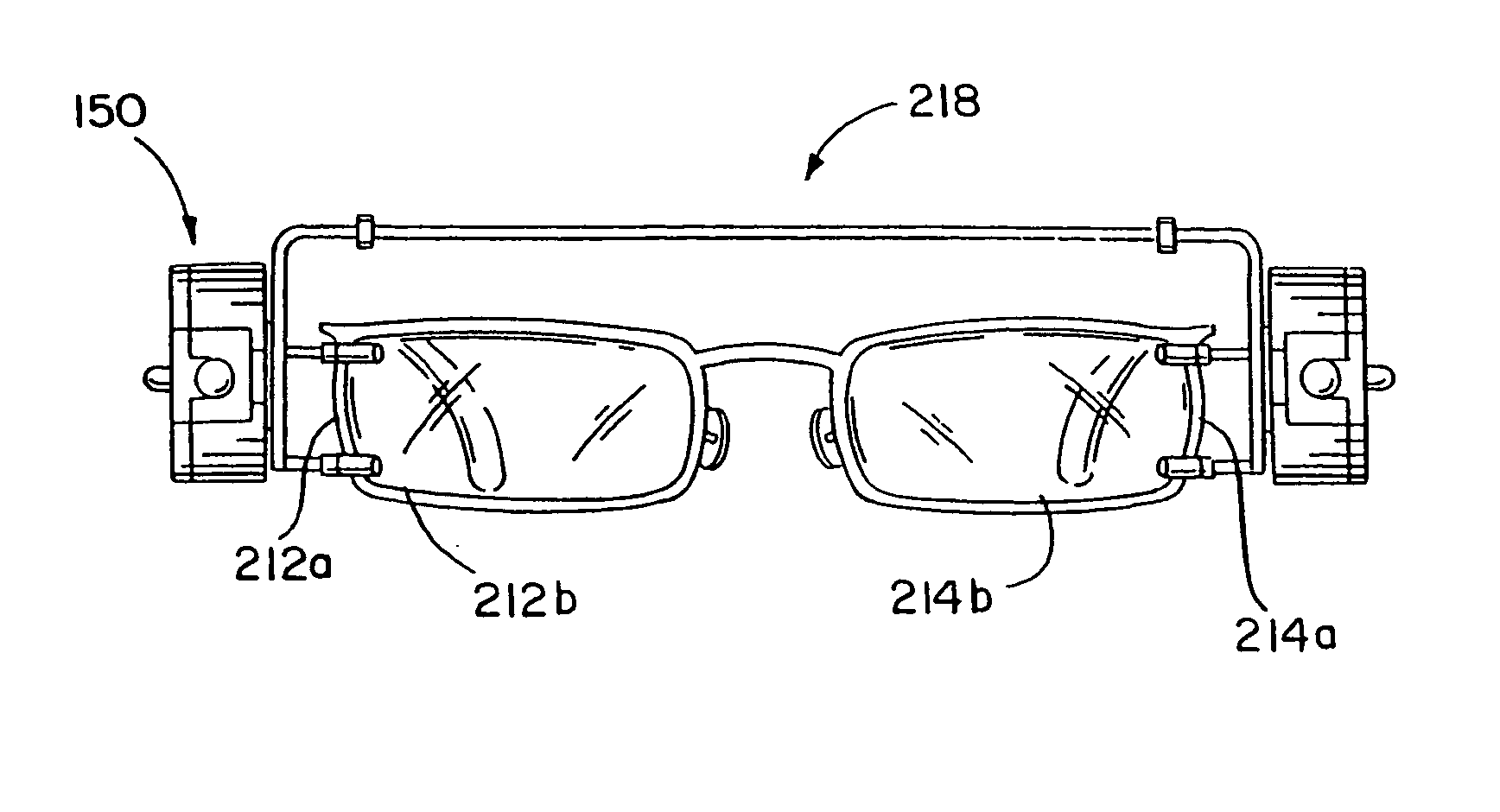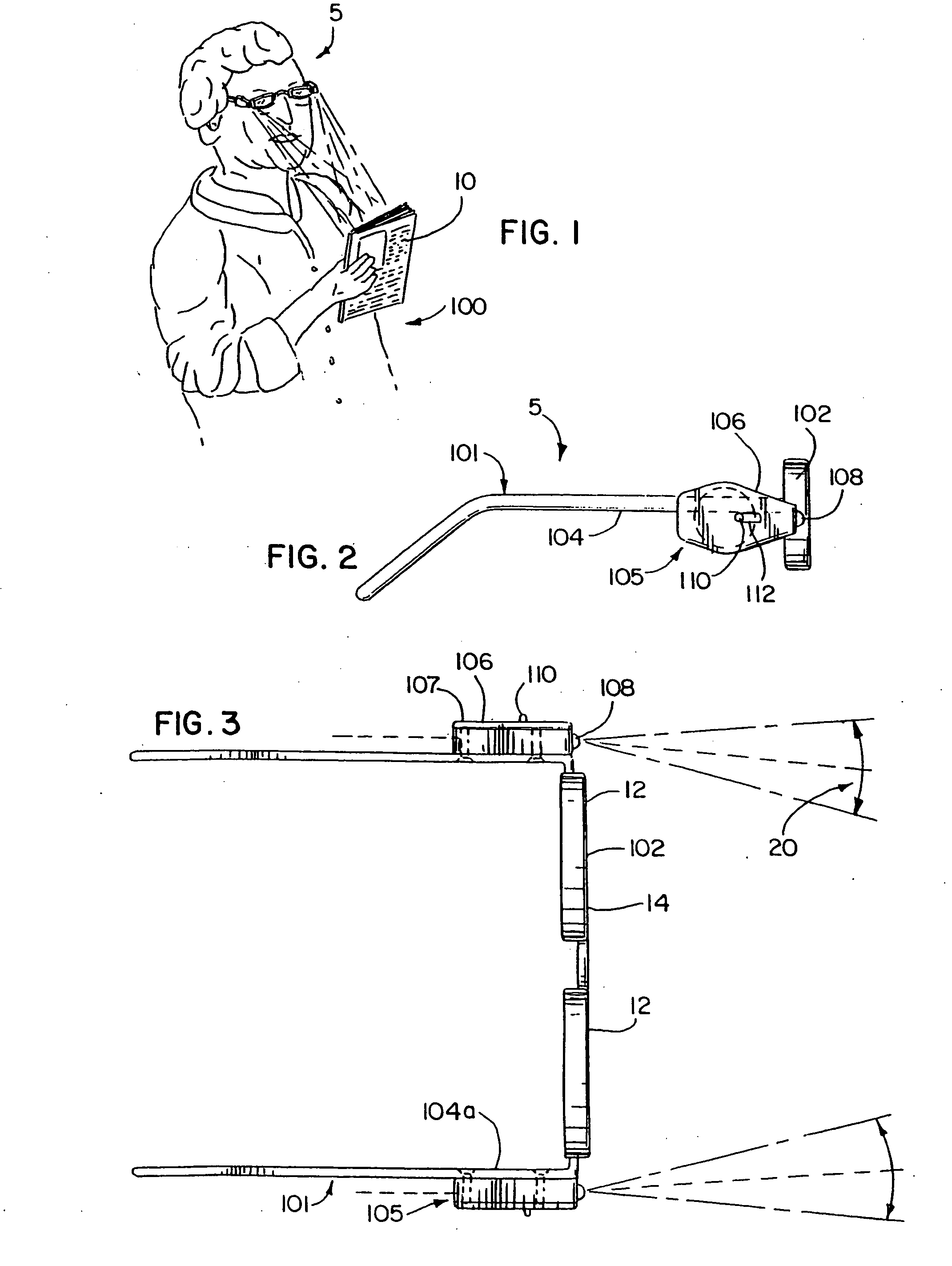[0010] In accordance with the present invention, lighted glasses, and preferably those adapted for reading which include corrective lenses, e.g., magnifiers, are provided to enable conventional sized text to be clearly read in dimly lit areas when held at a
normal range of reading distances at which a user typically reads such material, such as between ten inches and eighteen inches from the lenses. High strength lights and light mounts therefor cooperate to light the reading area with a maximum amount of light provided in the
reading distance range. More particularly, highly efficient and
high intensity light emitting diodes (LEDs) are mounted in housings configured to fix narrow beams of light to be directed slightly inward toward each other so that the beams overlap in the
reading distance range thus providing double the amount of light for reading over that provided by a single one of the lights. To this end, the housings are attached adjacent outer portions of the lenses so that the inwardly directed light beams light up the areas generally in front of the glasses, i.e., in its
field of view, and which begins spaced forwardly therefrom, i.e., generally coinciding with the start of the reading distance range. Further, the small size and efficient nature of the preferred
solid-state material, i.e. InGaN (
indium gallium nitride), for the LEDs, allows very small power supplies to be used such as disc-shaped
coin cell batteries for powering the LEDs which, in turn, allows both the light source and power source herein to be self-contained in a highly compact housing therefor. In this regard, the present invention also contemplates the provision of compactly sized lighting modules as described above that can be attached to reading or other glasses either removably or fixed in a more permanent fashion as described hereinafter, or to other items typically worn as headgear such as hats or the like.
[0011] The beams of light from the LEDs generate conical-shaped lighted areas such that upon intersection they cooperate to form a conical overlapping lighted area in which the brightness of the light is effectively doubled over that provided by a single LED. The conical overlapping lighted area increases in size as distances increase from the lenses. As is known, light tends to dissipate the further it is from its source. The overlapping conical lighted area is such that the
peripheral areas in the
field of view of the lenses that do not receive the double light strength of the overlapping light beams are closest to the lenses where light dissipation has its least effect in the reading distance range, whereas the overlapping lighted area increases in size further from the lenses with a corresponding decrease in the single light strength
peripheral areas on either side of the cone of overlapping light. Thus, as light dissipates and distances increase from the lenses, the lighting provided will not suffer as the double light strength of the overlapping conical region of light will more than make up for the effects of light dissipation in the reading distance range.
[0012] To achieve the optimum amount of light flooding in the reading area, the light housings have surfaces configured to orient the central axis of the conical light beams in a direction that is canted slightly inward with the beams directed toward each other. The preferred canting of the narrow light beams which in the preferred and illustrated form are cones forming angles of twenty degrees is such that the cone axis has a fifteen degree angle with a
reference line extending straight forwardly from the lenses. The lenses are preferably magnifiers of a predetermined diopter rating selected by a user so that conventionally sized text such as ten or twelve point
font can be clearly read at distances
ranging from between approximately ten and eighteen inches forwardly of the user. And it is in this distance range where the overlapping
cone of light is formed by the conical light beams canted inward toward each other, as described. In this way, the present lighted reading glasses are provided with lights whose light beams are directed in a carefully coordinated manner with the vision correction provided by the corrective reading lenses so that the amount of light is maximized where it is needed most, i.e., in the field of view of the lenses and within the range of distances at which conventional sized printed text is most commonly read.
[0014] The preferred LEDs herein are a small lightweight device that provide a very
bright light, while consuming very little power. As such, the batteries enclosed in the housing are small and do not need to be changed as frequently as devices that utilize incandescent lights or fiber
optics, which require large batteries. The LEDs provide a relatively
narrow beam of light that can be well focused in a particular direction. For example, if two light modules are mounted on a pair of glasses, the LEDs in each module are positioned such that the cones of light produced by the LEDs in the light modules begin intersecting at a point closely adjacent to or coinciding with the start of the range of ideal reading distances. As such, the illuminated reading portion receives the brightest light possible since the intersection of both cones of light are trained on that area. Another
advantage of using the
high intensity LEDs is that because they consume such a small amount of power, virtually no heat is dissipated. Therefore, a user is able to wear eyeglasses having the light modules mounted thereon, for longer periods of time without suffering from heat and without being bothered by the weight of the devices.
 Login to View More
Login to View More  Login to View More
Login to View More 


